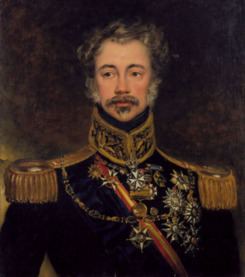Monarch Luis I Name Joao de Succeeded by Duke of Loule | Preceded by Duke of Loule | |
 | ||
Succeeded by Marquis of Sa da Bandeira Monarch Maria II and Fernando II | ||
Dom João Carlos Gregório Domingos Vicente Francisco de Saldanha Oliveira e Daun, 1st Duke of Saldanha, GCSMOM GCC GCTS GSJS GCICVV FC (17 November 1790 – 20 November 1876; [saɫˈdɐɲɐ]) was a Portuguese marshal and statesman.
Contents
Early Life and Schooling

Saldanha was born on 17 November 1790, in Arinhaga. He was a grandson of Sebastião José de Carvalho e Melo, 1st Marquis of Pombal, the Secretary of the State of the Kingdom of Portugal and the Algarves to King Joseph I of Portugal.
Saldanha studied at Coimbra, served against the French, and was made a prisoner in 1810. On his release he went to Brazil, where he was employed in the military and diplomatic services. He returned to Portugal after the declaration of the independence of Brazil.
Liberal Wars
The Duke of Saldanha, as he is commonly known, was one of the most dominating personalities of war and politics in Portugal, from the revolution of 1820 to his death in 1876. During that period he led no less than seven coups d'état. He played an important part in the struggle between brothers Pedro IV of Portugal (I of Brazil) and Miguel of Portugal during the Liberal Wars.
Saldanha became Minister of Foreign Affairs in 1825 and was governor of Porto in 1826–27. He joined Dom Pedro against the usurper Dom Miguel, with whom he concluded the Concession of Evoramonte. In 1835 he was made Minister of War and President of the Council but resigned the same year. After the revolution of 1836, which he had instigated he went into exile until recalled in 1846.
Later life
After his return from exile in 1846 Saldanha was made Duke of Saldanha, and formed a Ministry which fell in 1849. In 1851 he organized a new revolt and became chief Minister as the leader of a coalition party formed of Septembrists and dissatisfied Chartists. He remained in power until the accession of Pedro II. in 1856. and was subsequently Minister to Rome (1862–64 and 1866–69). He became Prime Minister once more for a few months in 1870 (May–August), and was sent in 1871 to London as Ambassador, where he died.
Assessment
Terence Hughes wrote a character sketch of Saldanha in 1846:
The Marshal Duke de Saldanha ... is a very noble-looking old soldier, whose appearance, manners, and accomplishments would do honour to any noblesse in Europe. His hair, moustache, and whiskers, which he wears rather full, are as white as snow and contrast extremely well with the soldiery brown of his complexion. His nose is a little blunt, but his mouth is benevolent, his eyes bright and expressive, and his forehead expansive. He is about the middle height, and has an easy and gentlemanly figure—remarkably upright for a man who must be at least sixty-two years of age.
The Duke is equally distinguished in arms and diplomacy, having served during the entire Peninsular War, and subsequently took an active part in the war against Dom Miguel. He is by far the ablest general in Portugal, and about the eminence of his strategic talents there is no dispute whatever.
Works
Saldanha was an accomplished linguist (he spoke English, French, and German with perfect fluency) and a general scholar. He wrote On the Connexion between true Sciences and Revealed Religion which was published in Berlin.
Family
Saldanha had a son who died in Berlin in 1845.
